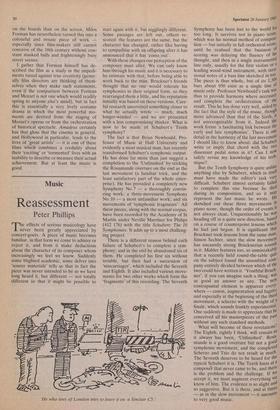Music
Reassessment
Peter Phillips
The effects of serious musicology have 1 never been greatly appreciated by concert-goers. A piece of music becomes familiar, in that form we come to admire or reject it, and from it make deductions about the character of its composer whom increasingly we feel we know. Suddenly some blighted academic, some delver into 'source materials' tells us that in fact the piece was never intended to be as we have long heard it, but different — not totally different so that it might be possible to start again with it, but nigglingly different. Some passages are left out, others re- scored: the features are the same, but the character has changed, rather like having to sympathise with an offspring after it has announced that it has 'come out'.
With these changes our perception of the composer must alter. We can only know him through his music and it is necessary to be intimate with that, before being able to work back to the man. Bruckner's friends thought that no one would tolerate his symphonies in their original form, so they rearranged them a little, and his reputation initially was based on these versions. Care- ful research uncovered something closer to what he actually wrote — much, much longer-winded — and we are presented with a less compromising thinker. What is now to be made of Schubert's Tenth symphony?
The fact is that Brian Newbould, Pro- fessor of Music at Hull University and evidently a most musical man, has recently transformed Schubert's symphonic output. He has done far more than just suggest a completion to the 'Unfinished' by sticking the Rosamunde overture on the end as the last movement (a familiar trick, and the least satisfactory part of the whole enter- prise). He has provided a completely new Symphony No.7 — a thoroughly convin- cing work; a three-movement Symphony No.10 — a most unfamiliar work; and six movements of 'symphonic fragments'. All these pieces, along with the normal corpus, have been recorded by the Academy of St Martin under Neville Marriner for Philips (412 176) with the title Schubert: The 10 Symphonies. It adds up to a most challeng- ing project.
There is a different reason behind each failure of Schubert's to complete a sym- phony; and in the end he abandoned six of them. He completed his first six without trouble, but then had a succession of 'miscarriages', which included the Seventh and Eighth. It also included various move- ments for two other works which form the 'fragments' of this recording. The Seventh 'He who tires of London tries to leave it on a Sinclair C'5.' Symphony has been lost to the world for too long. It survives not in piano score, which was his normal method of compose' tion — but initially in full orchestral score, until he realised that the business of scoring was delaying the fluency of his thought, and then in a single instrumental line only, usually for the first violins or a leading wood-wind instrument, with occa- sional notes of a bass line sketched in too. The piece is thus whole, but of its 1,0 bars about 950 exist as a single line of music only. Professor Newbould's task was thus to provide harmony where necessary and complete the orchestration of the result. This he has done very well, aided by the fact that the style of the music, though more advanced than that of the Sixth, j5 not unrecognisable from it. Indeed the work forms 'a fascinating link between the early and late symphonies'. There is one detail in the harmony of the last movement I should like to know about: did Schubert write or imply that chord with the two dissonant pedal notes in it? Can I now safely revise my knowledge of his tech. nique? But the Tenth Symphony is quite unlike anything else by Schubert, which in itself must have made the editor's task veil difficult. Schubert almost certainly failed to complete this one because he died during its composition, and so it may represent the last music he wrote. He sketched out these three movements in piano score, though the order of events is not always clear, Unquestionably he vas, heading off in a quite new direction, based on a course of counterpoint lessons which he had just begun. It is significant that Bruckner took lessons from the same man' Simon Sechter, since the slow movement has uncannily strong Brucknerian sounds in it. Mahler features too, so unmistakablY that a recently held round-the-table Oa on the subject found the assembled coin' pany entirely divided between which of the two could have written it. 'Youthful Bruck' ner', if you can imagine such a thing, was as good an answer as any. The new contrapuntal element is apparent even' where — canon, augmentation and fugato; and especially at the beginning of the third movement, a scherzo with the weight of a finale, which sounds frankly experimental. One suddenly is made to appreciate that he conceived all his masterpieces of the Past without any such standard methods.
What will become of these revelations. The Eighth, rightly I think, will remain as it always has been, 'Unfinished'. Rosa- munde is a good overture but not a good symphonic movement, and the completed Scherzo and Trio do not result in much.
The Seventh deserves to be heard for the typical Schubert it is. The Tenth hints at a composer that never came to be, and there
is the problem and the challenge. If We accept it, we must augment everything we.,
know of him. The evidence is so slight and so suggestive. But it is there, and at times — as in the slow movement — it amounts to very good music.










































 Previous page
Previous page